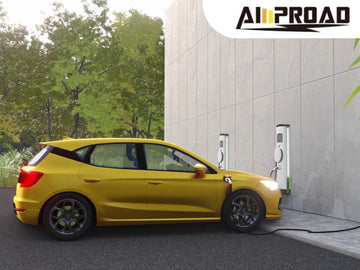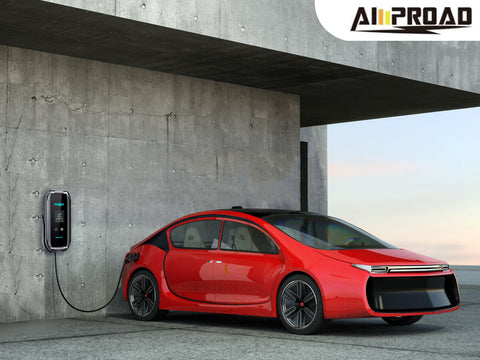
Plugging in your electric vehicle (EV) might seem like a mystery compared to filling up a gas tank. But fear not! The J1772 connector is your key to unlocking the world of EV charging. Imagine it as the universal adapter for most EVs in North America (except Tesla). This handy plug, also known as the J Plug, connects your car to charging stations, allowing you to conveniently juice up your battery.
J1772 is the standard for Level 1 and Level 2 AC charging. Level 1 charging is like a slow trickle, perfect for topping off your battery overnight at home using a standard outlet. Level 2 charging provides a significant power boost, similar to a high-speed gas pump, and can recharge your EV in a few hours. So, next time you see a J1772 connector at a charging station, you'll know it's your friendly neighborhood plug, ready to power up your electric adventure. But is it AC or DC delivering the juice? Let's dive into the world of electric currents!
What is the difference between AC (Alternating Current) and DC (Direct Current)?
We've learned about the J1772 connector, the hero of EV charging stations (except Tesla). But what kind of electrical current flows through this trusty J Plug to give your electric vehicle (EV) a boost? Understanding the difference between AC (Alternating Current) and DC (Direct Current) is key.
Imagine your home appliances running on electricity. That flow can be either AC or DC. Think of AC current like a wave, constantly changing direction. This is the type of electricity delivered through your home outlets and used by most appliances, including Level 1 and Level 2 EVSE (Electric Vehicle Supply Equipment) stations that utilize the J1772 connector.
On the other hand, DC current is like a steady stream flowing in one direction. This is the kind of electricity that directly powers your EV's battery. However, J1772 doesn't deliver DC directly. Here's the twist: the J1772 connector supplies AC power to an onboard charger within your EV. This internal charger then converts the AC to DC for efficient battery charging.
So, while the J1772 connector itself deals in AC, it acts as the middleman, ultimately delivering the DC current your EV's battery craves. In the next section, we'll explore an alternative charging method that skips the AC to DC conversion step: DC Fast Charging.
How does AC and DC electricity differ in their flow and use?
All right, let's delve into the world of electrical currents! Imagine your home appliances running on electricity. That flow of electricity can be either AC (Alternating Current) or DC (Direct Current). Here's how they differ:
- AC (Alternating Current): Think of AC current like a wave, constantly changing direction. It's like a back-and-forth flow of electrons, similar to the rhythm of the ocean tides. This is the type of electricity delivered through your home outlets and used by most appliances, including your J1772 charger. A Level 2 EV charger, which utilizes the J1772 connector, also delivers AC power.
- DC (Direct Current): In contrast, DC current is like a steady stream flowing in one direction. Imagine a river continuously moving forward, similar to the flow of water in a garden hose. This is the kind of electricity that directly powers your EV's battery. It provides a constant push to charge the battery efficiently.
Here's the twist when it comes to J1772 charging:
J1772 Delivers AC, But Your Battery Prefers DC: The J1772 connector itself supplies AC power to your car. But wait, isn't the battery powered by DC? That's right! Here's where some magic happens inside your EV. The J1772 charger acts as an intermediary. It delivers AC power, but your EV has a built-in onboard charger that acts like a translator. This onboard charger converts the incoming AC current from the J1772 connection into DC current, the type your battery needs to power up.
In essence, the J1772 connector acts as a middleman, delivering AC but enabling the internal conversion to DC within your EV for efficient battery charging. This AC to DC conversion process adds a bit of time to charging compared to DC Fast Charging, which we'll explore next. While Level 2 EV chargers provide faster charging than Level 1 chargers using the J1772 connector, they both rely on this AC to DC conversion within your vehicle.
While some manufacturers are exploring innovative charging solutions, the AMPROAD iFlow P9, like most Level 1 and Level 2 EV chargers, functions as an AC J1772 charger. It delivers AC power through the J1772 connector, and your EV's onboard charger converts that AC to DC for battery charging. This AC to DC conversion process adds a bit of time to charging compared to DC Fast Charging, which we'll explore next. Even though the AMPROAD iFlow P9 offers adjustable amperage for Level 1 and Level 2 charging, it relies on this internal AC to DC conversion within your vehicle for both charging levels.
Does the J1772 connector use AC or DC current for charging EVs?

The J1772 connector actually functions as an AC (Alternating Current) delivery system. Imagine electricity like water flow. AC current is like waves constantly changing direction, similar to the tides in the ocean. This is the type of electricity powering your home and most appliances, including the J1772 charger.
But here's the twist! Your EV's battery thrives on DC (Direct Current), a steady flow in one direction, like a running river. So, how does the J1772 bridge this gap?
The J1772 acts as a middleman. It supplies AC power to your car, but your EV has a built-in hero: the onboard charger. This onboard charger is like a translator, efficiently converting the incoming AC current from the J1772 into DC current that your battery needs to recharge.
In essence, the J1772 provides AC, but enables the magic of internal conversion to DC within your EV for optimal battery charging. This AC to DC process adds a bit of extra time to charging compared to DC Fast Charging, which we'll explore next. So, next time you plug in your J1772 connector, remember the hidden hero – the onboard charger – working tirelessly to convert AC into DC power for your EV's happy battery.
How does the J1772 standard facilitate AC charging for electric vehicles?
The J1772 standard is like a universal adapter for AC charging most electric vehicles in North America (except Tesla). It ensures compatibility between your EV and charging stations. Imagine the J1772 connector as a bridge. It delivers AC power from the station to your car's onboard charger. This built-in charger then acts like a translator, efficiently converting the AC current into DC (Direct Current) that your battery needs to recharge. J1772 comes in two flavors: Level 1 slow EV home charger using a regular outlet, and Level 2 for faster charging at public stations.
Are there other charging methods besides J1772 for EVs?

The J1772 connector reigns supreme for AC charging in North America (except Tesla), but it's not the only player in the EV charging game. Here's a glimpse into some alternative methods:
- DC Fast Charging (DCFC): If you're short on time and need a quick energy boost, DC level 3 EV charger (also known as DCFC) is your best friend. Unlike J1772 which utilizes AC, DC Fast Charging stations deliver DC power directly to your EV's battery, bypassing the onboard AC to DC conversion step. This translates to significantly faster charging times, often topping up your battery in under an hour–perfect for long road trips. However, DC Fast Charging stations are less common than J1772 chargers and can be more expensive to use.
- Tesla Superchargers: Tesla has its own proprietary network of DC Fast Charging stations called Superchargers. These stations are specifically designed for Tesla vehicles and offer exceptional charging speeds. While convenient for Tesla owners, they're not compatible with other EV makes using the J1772 standard.
- Combo Charging System (CCS): Looking for a future-proof option? The Combo Charging System (CCS charger) combines the functionality of J1772 (for AC charging) with an additional port for DC Fast Charging. This allows a single connector to handle both AC and DC charging needs, potentially simplifying the charging experience in the future. CCS is becoming increasingly popular in North America and Europe, but J1772 remains the dominant standard for AC charging currently.
- NACS (North American Charging Standard): This standard is primarily used in Japan and focuses on DC charging. While not as widespread in North America as J1772 or CCS, it's worth mentioning as a potential future player, especially as collaborations between automakers from different regions increase.
- Tesla Destination Chargers: While Tesla uses its own Supercharger network for DC Fast Charging, they also offer Tesla Destination Chargers at locations like hotels and resorts. These destination chargers typically use a special Tesla proprietary connector, different from the J1772 standard. However, they often provide Level 2 AC charging speeds, making them a convenient option for Tesla owners to top up their batteries while on the go.
Remember, the terms EVSE (Electric Vehicle Supply Equipment) and EVCS (Electric Vehicle Charging Station) are often used interchangeably and refer to the overall charging infrastructure, including the connector type (like J1772 or CCS). So, next time you're on the road, keep in mind that J1772 might not be the only charging option available, and different standards cater to various charging needs and speeds.



